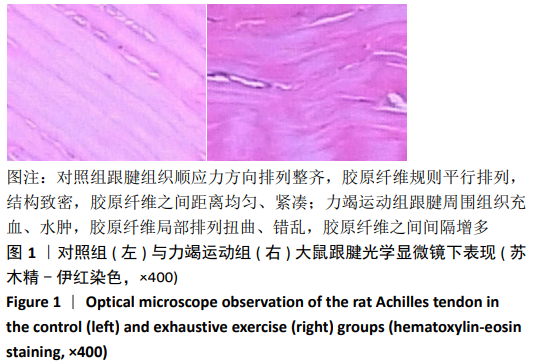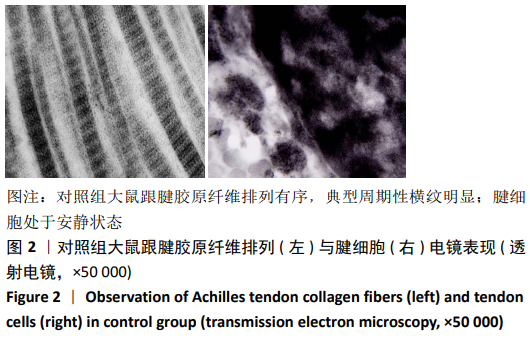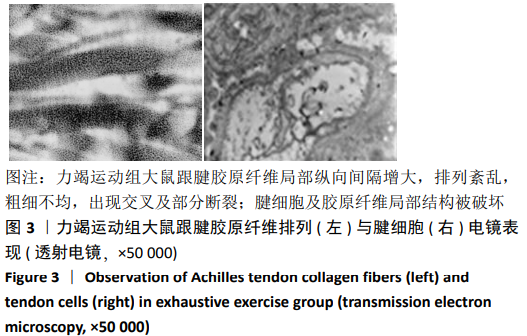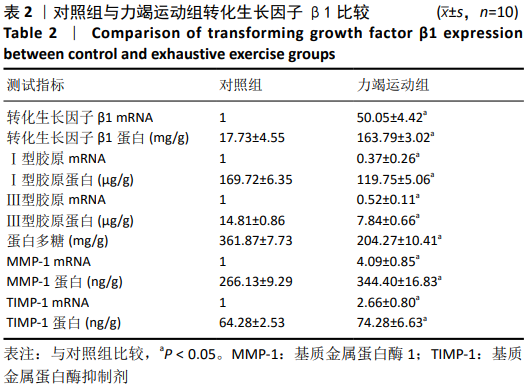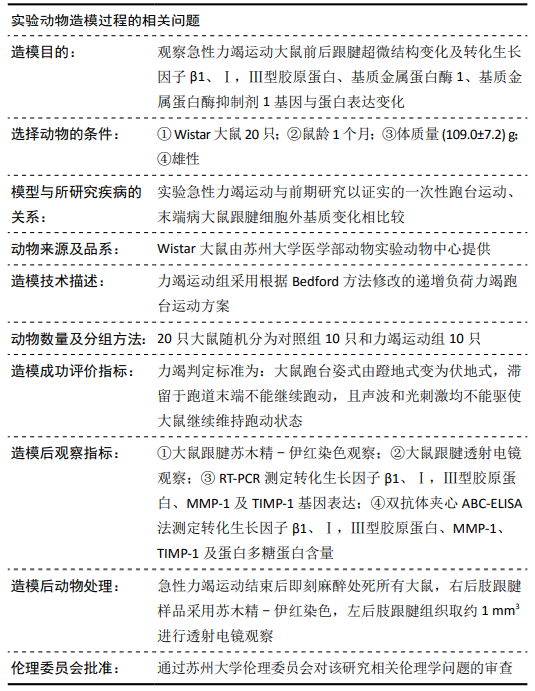中国组织工程研究 ›› 2021, Vol. 25 ›› Issue (8): 1190-1195.doi: 10.3969/j.issn.2095-4344.2990
• 肌肉肌腱韧带组织构建 tissue construction of the muscle, tendon and ligament • 上一篇 下一篇
急性力竭运动导致大鼠跟腱微损伤的超微结构变化及机制
申晋波1, 2,张 林2
- 1运城学院体育系,山西省运城市 044000;2苏州大学体育学院,江苏省苏州市 215021
Micro-injury of the Achilles tendon caused by acute exhaustive exercise in rats: ultrastructural changes and mechanism
Shen Jinbo1, 2, Zhang Lin2
- 1Department of Physical Education, Yuncheng University, Yuncheng 044000, Shanxi Province, China; 2School of Physical Education, Soochow University, Suzhou 215021, Jiangsu Province, China
摘要:
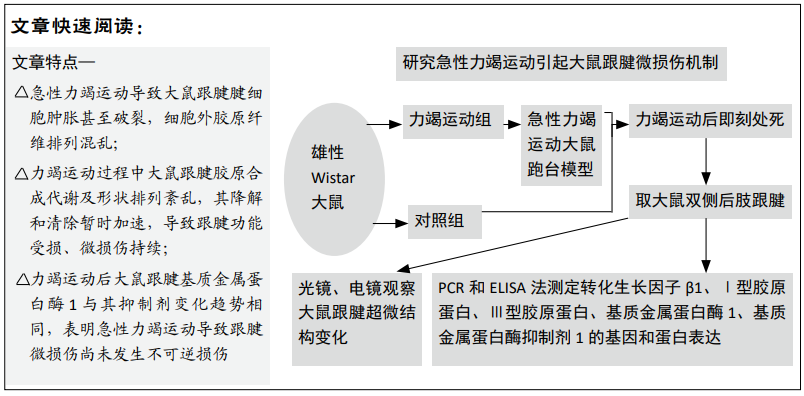
文题释义:
转化生长因子β1:是转化生长因子β的一种亚型,是常见的生长因子,几乎存在于所有细胞中,在调节细胞增殖与分化、细胞外基质合成及损伤愈合修复等方面发挥作用。由多基因家族编码的多肽因子,有特异的氨基端序列,以前多肽形式存在,在酸性环境中或经蛋白溶解酶水解后被激活。
基质金属蛋白酶:水解细胞外基质的蛋白裂解酶,作用过程需要钙、锌等离子作为辅助离子参与而得名,包括基质中的各种胶原酶和弹性蛋白酶等,是参与降解全身各种组织细胞外基质的蛋白酶家族。
背景:有研究表明末端病大鼠跟腱所形成的损伤和瘢痕修复难以痊愈,而力竭运动所致大鼠跟腱微损伤的早期治疗有避免损伤累积和预防末端病发生的作用,因而有必要探索急性力竭运动引发跟腱微损伤的机制。
目的:通过对比急性力竭运动前后大鼠跟腱的超微结构、转化生长因子β1、Ⅰ型胶原、Ⅲ型胶原、基质金属蛋白酶1和基质金属蛋白酶抑制剂1基因与蛋白表达变化,探讨急性力竭运动引起跟腱微损伤的机制。
方法:将大鼠随机分为2组,对照组不运动为空白对照,力竭运动组进行急性力竭跑台运动,力竭运动后即刻麻醉处死对照组和力竭运动组大鼠,对大鼠跟腱进行苏木精-伊红染色光学显微镜及透射电镜观察,通过反转录聚合酶链式反应技术和双抗体夹心ABC-ELISA法测定两组大鼠跟腱组织转化生长因子β1、Ⅰ型胶原蛋白,Ⅲ型胶原蛋白、基质金属蛋白酶1及基质金属蛋白酶抑制剂1的基因表达和蛋白含量。
结果与结论:与对照组相比,力竭运动组大鼠跟腱胶原纤维排列紊乱,腱细胞局部结构被破坏,转化生长因子β、基质金属蛋白酶1、基质金属蛋白酶抑制剂1基因表达和蛋白含量显著升高(P < 0.05),Ⅰ型胶原蛋白、Ⅲ型胶原蛋白基因表达和蛋白含量显著下降(P < 0.05)。上述数据说明,急性力竭运动过程中大鼠跟腱发生微损伤并逐步累积导致转化生长因子β1过高表达;大鼠跟腱胶原合成下降,降解加速,跟腱功能受损、微损伤持续;基质金属蛋白酶1与基质金属蛋白酶抑制剂1变化趋势相同,表明尚未发生不可逆损伤;提示急性力竭运动后跟腱发生的微损伤应及时治疗和修复,以避免形成过度损伤和瘢痕修复。
https://orcid.org/0000-0003-1346-4739(申晋波);https://orcid.org/0000-0001-9901-0118(张林)
中国组织工程研究杂志出版内容重点:组织构建;骨细胞;软骨细胞;细胞培养;成纤维细胞;血管内皮细胞;骨质疏松;组织工程
中图分类号:
